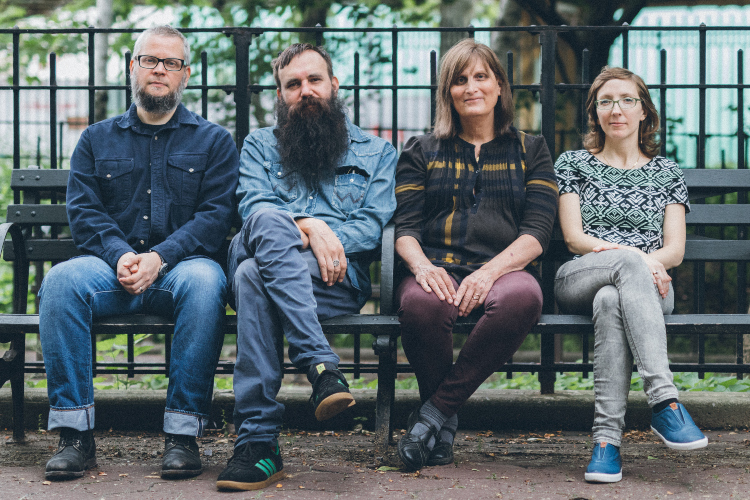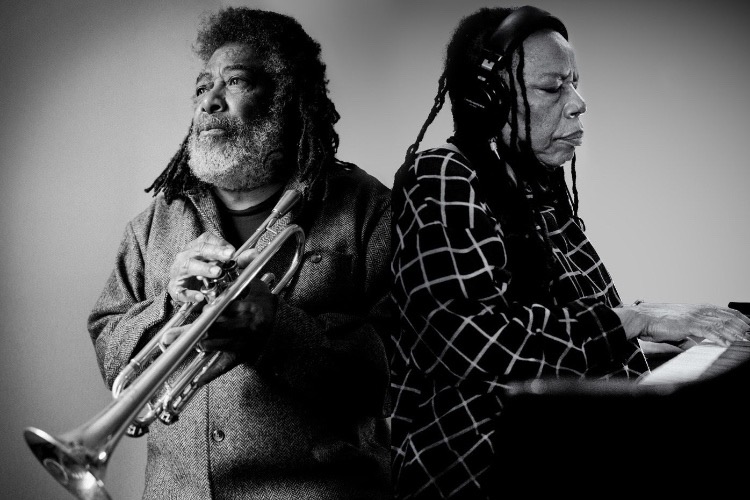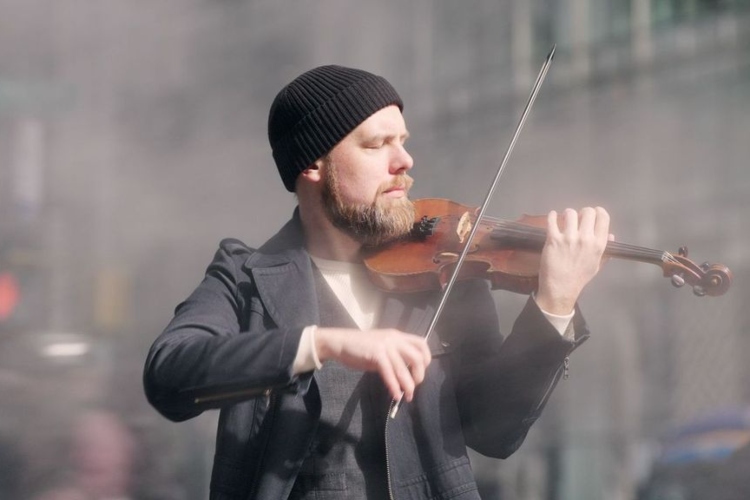Human Nature: A Conversation with Nate Wooley (Part One)
|
Getting your Trinity Audio player ready...
|
Throughout history, humans have struggled to understand their place in nature. Often, however, perspectives on nature have at least bordered on antagonistic. Even the most cursory reading of Thomas Hobbes reveals the perspective that, in nature, human lives are “brutish and short.” But the reality of mankind’s relationship with nature is far more complicated. Despite every social instinct to escape, the natural world plays a vital role in human well-being. The same forces that can threaten hasty death are often also viewed with wonder and awe. The human relationship to nature is hardly a novel topic for musicians, whether Vivaldi’s vivid imagery of the seasons or John Denver’s ode to mountains. But, often, these statements simplify the matter by emphasizing one facet of the relationship over another. Enter Nate Wooley and Columbia Icefield (Mary Halvorson, Susan Alcorn, and Ryan Sawyer). With Ancient Songs of Burlap Heroes (Pyroclastic, 2022), the quartet dives deeper, climbs higher, and voyages further to expose man’s relationship to nature in a more accurate and personal light.
Noticeably, over half the tracks on the album forego proper titles in favor of dots eclipsed with parentheses. Often these interludes are built around the sounds of nature: the chirping of birds, a ferocious wind, or water crashing on rocks. The absence of proper titles underscores that these phenomena occur despite human input. And yet, careful listening reveals more. Sometimes the recordings pick up the sounds of people or man-made machines in nature. At other moments, even the purely natural is altered and modified by artificial human means. The message left seems to be that while humanity does not create environmental processes, it certainly can impact them. This is perhaps most apparent on the final piece, where the band subsides into a dialogue between water and trumpet before lonesome – though sometimes altered- waves disappear into remarkable silence.
Ancient Songs also presents the narrative of humanity’s struggles with and against the natural world. Perhaps more than traditional melodies and harmonies, the group paints a sonic environment over which humanity – represented by the leader’s horn- can explore the surrounding world. Often the ensemble presents a sound reminiscent of a Morricone score, albeit moved out of an arid Southwestern desert and into the desolate and frozen waters of the North. Wooley’s tone across the voyage sounds equal parts mournful of those lost on the trek and triumphant for the survivors. But even when nature subsumes all, there is an inherent humanity to Ancient Songs. Much of this ineffable human nature comes from the cues of folk music, specifically the reliance on pure emotion more than technical prowess.
In the first part of our conversation with Nate Wooley, we discuss the album’s unique approach to folk traditions and nature. In the second, we address the necessity of an artist to present their own voice, lessons learned from Ron Miles and Anthony Braxton, and the breaking down of barriers around experimental music.
PostGenre: Often, with a band’s follow-up album, the question becomes what sets the release apart from its predecessor. But Ancient Songs of Burlap Heroes sounds very different from Columbia Icefield (Northern Spy, 2019). Perhaps the better question is, do you see the two as connected in some way beyond being mostly the same group of musicians?
Nate Wooley: In a certain sense, I do see the two as connected. I think, philosophically, the band is still the same to me. With both albums, I wanted to approach music differently than I have in my other projects. I wanted to do something outside of the music I had been making, whether you call that “jazz”, “experimental”, or something else entirely.
With the first record, I was trying to figure out how to move beyond the types of music I typically make. It was partly a learning process. With Ancient Songs, I think I found something that felt a little more natural to me as a composer and a trumpet player. On the first one, I tried to find a new sound by radically restructuring the relationship between composition and improvisation. I think Ancient Songs may be more of an organic outcropping of the sounds in my head. It ended up connecting with the folk music I listened to growing up. By that, I do not mean folk with a capital “F”.
PG: You mean less the music marketed as “Folk” and more an organic form of music made by people in their natural space?
NW: Yes. There’s a certain quality to folk music. I don’t even know how to describe it. In my mind, there is a certain wonkiness or quirkiness to folk music. There is this beauty in the imperfection of someone playing banjo who is maybe not a formally trained musician. Many of the moments on this album felt like they needed that kind of presence; something strange and different beyond what the group did on the first album.
PG: Sometimes people define folk music as “coming from the people.” But that definition seems flawed. “Jazz” is certainly coming from “the people” but many hesitate to characterize it as folk music. Do you think there is something inherent in improvised music that makes it less likely to be characterized as folk music?
NW: I’m not sure. I do think there is a tendency, and probably rightfully so, to think of improvised music as being incredibly complex. Complex to the point that some people feel it is above their head. In some improvised music, such complexity is even the goal. I like that kind of music and understand the appeal of complexity. But that is generally different from folk music, where the emphasis seems to be less on complexity.
PG: Though not all folk music is simple.
NW: Yes. Sometimes people give folk a pejorative meaning and equate it with something simple, but that is inaccurate. And not all folk music is easy listening. For instance, Roscoe Holcomb is not an easy-listening artist. But it does seem folk music more heavily emphasizes the formation of a direct one-to-one influence on the listener. Of course, all musicians want to have some connection with their audience. But there is something about sitting around a campfire telling stories. With folk, that storytelling element plays a central role. Folk music leaves something that needs to be tended to.
PG: There is a rawness to the music.
NW: Right, exactly. Rawness was the word I was seeking. Folk music is so raw and human, with all of its imperfections. The music aims to tell stories that are common throughout the human experience. They resonate with everyone regardless of who they are, where they grew up, or what they have learned. The music speaks to certain things all humans deal with: pride, shame, love, and frustration. The goal with the album was to take what I love most about folk music – that direct storytelling and narrative rawness – and figure out how to do a version that would fit the group.
PG: “Returning To Drown Myself, Finally” has a particularly strong connection to folk music as it is based on a Swedish dalakoral, a religious song, named “Nu är midsommar natt.”
NW: Right.
PG: Your hometown of Clatskanie, Oregon, has a significant population of people of Nordic heritage. In choosing to explore a Swedish folk song, did you intend to represent your hometown?
NW: My family is Swedish. Clatskanie has a heavy Finnish population, and there are also many people of Norwegian heritage. Finnish and Norwegian cultures are both very different from Swedish. That said, however, each of the Nordic countries shares a common feeling that reflects a seafaring culture, and those aspects are an inescapable part of Clatskanie. The city has a salty downtown mariner vibe and is away from bigger cities; it is about a half hour from Astoria and an hour away from Portland. It is that vibe that I hoped to capture with the dalakoral. I wanted the songs to come to a very human place at the end, no matter how strange they became before getting there. I wanted something at the end that people could sing.
I didn’t think I was too familiar with dalakorals when I started work on the composition. Someone sent me a beautiful record of a woman singing several dalakorals. They are usually unaccompanied. You would sing them at home and never think to have a harmony with them. I loved the austerity of the dalakoral. As I started to learn some of the pieces, I realized I had heard them growing up. People, especially older folks, sang them in different places in that part of Oregon. I doubt many people from Clatskanie would remember them now, generations later, but long ago, people sang them in my hometown.
There was something that felt very natural about playing the dalakoral. It is in a super awkward key, but it still felt right. I kind of ruined it by adding a bunch of harmonies underneath it. [laughing]. But I still wanted to try and keep the song feeling as if it had been sung by a single voice.
PG: While the dalakoral is typically a solo acapella piece, “Returning To Drown Myself, Finally” is wholly instrumental. Do you feel that approaching folk music from an entirely instrumental approach provides any additional opportunities to get to the core emotion of a song in a way that may be difficult with more vocal-based works?
NW: I don’t think so, necessarily. However, with Ancient Songs, I also didn’t set out to make a folk-oriented record. To be honest, I was initially aiming to make a second Columbia Icefield record. The folk aesthetic partly came out of the group’s instrumentation. I think anytime you have pedal steel [guitar], it’s hard to get away from that instrument’s folk roots, even if it is being played by Susan [Alcorn], who approaches her instrument in a revolutionary way.
PG: It seems part of the album’s rawness comes from its use of field recordings of various birds, water, and other natural sounds. What are your thoughts on the interplay between human-made music and the sounds of nature?
NW: That thought has been a big thing for me since I was young. While I didn’t grow up alone, I was kind of a loner as a kid, by choice. There were a lot of sounds I latched onto in my youth that gave me great comfort when I needed it, whether my grandmother’s humming or the wind blowing through the trees. I grew up in a very forested place. You can hear the frogs or birds without the sounds of cars interrupting the experience. It is that purity of natural sounds that I have always tried to achieve on my trumpet. The music on Ancient Songs is kind of the most overt version of my exploration of the sounds of nature. But the field recordings are not only of nature but of human beings in nature. In the opening track, you can hear someone getting into their truck and driving over a bridge. Elsewhere, you can hear people moving around. Or even my sniffling from sitting outside in the rain too long. They are not just the sounds of humans, but humans out where they should be, in nature.
PG: One interesting thing about the field recordings is your electronic manipulation of them. What was your thought process behind manipulating the recordings?
NW: Those were primarily a means to transition between things that were overtly human and overtly natural in each song. I hoped that adding the manipulations would make the listener feel like they are in a certain sonic environment for the whole album, not just listening to a record.
PG: The field recordings were captured in Maine. You are using them partly to reflect upon your relationship with nature growing up in Oregon. The Columbia Icefield itself is in Canada. By referencing geographically diverse spaces, were you making a broader comment on the borderless aspect of nature?
NW: Not particularly. The recordings were made in Maine primarily due to logistics, not an intentional statement. I live in New York now and can get up to Maine easier than I can back to Oregon. That was especially the case when these were recorded, at the height of the pandemic. I also don’t have easy access to the Columbia Icefield for the same reason. But there was something cathartic about capturing the ones on this album in Maine. My wife and I were there for a few weeks at the end of an incredibly stressful time, and there was something special about the quiet of that place.
But there is also a connection between Maine and Oregon due to their common access to water. The sound of water and the proximity of water is an essential parts of the recordings. The sounds of boats and people going fishing are also a big part of who I am. I certainly feel a connection because of that shared connection to water. Actually, in many ways, that part of Maine – very far north, near Canada- parallels where I grew up in Oregon.
PG: What was your process for combining the field recordings with your compositions? Did you write the parts around the recordings, or did you incorporate the recordings into already formed pieces?
NW: The compositions came first. The first piece [“I am the Sea that Sings of Dust”] came to me as relatively fully formed. As I started to consider what else I should put on the record, I gradually wrote the second [“A Catastrophic Legend”]. And the third piece [“Returning to Drown Myself, Finally”], the dalakoral. The three pieces worked well together but needed something to make them complete. I happened to be going to Maine around that time and had decent field recording equipment, so I saw if those recordings would help better tie the entire record together, which they did.
PG: There was no preexisting plan with the field recordings?
NW: No, but that is not necessarily a bad thing. I also didn’t plan on it being such a studio record. I didn’t plan on doing a lot of the overdubbing and weird kind of psych stuff that happens throughout the record. And I didn’t completely plan on having guests. Those are all things that came into focus only once I had the elements at hand.
PG: Of course, the guests you refer to are Mat Maneri on viola and Trevor Dunn on bass. What inspired you to add them to the album?
NW: Well, it came from incorporating folk elements into the music. Digging deeper into folk music led me down a path of considering what it would be like to have a strange version of the Carter family. Or a strange version of Charlie Haden playing with his family band. There is so much history of folk influences that run through free improvisation and free jazz.
That line of thought, in turn, led me to fiddle music and the idea of what it would sound like to have the least “fiddle-like” person doing something in that context. That thought instantly led me to Mat. His viola playing is both so elegant and radical. But it is also so human and organic. His sound is kind of dirty and bloody and was perfect for the song [“I am the Sea that Sings of Dust”]. I feel Mat added the capability to reach the folk place in music that I sought. Far too often people focus on what is or isn’t in the “jazz” idiom, and it sometimes makes it more difficult to reach beyond the “jazz” space when you come from that background. Mat is one of those artists who can reach further, expertly. I knew he would be a great addition to the project and the solo he played was the most natural and perfect thing. You hear him breathing in his music. It felt just right.
PG: And Trevor?
NW: I’ve always kind of heard Trevor in this band. Susan covers a lot of the bass functions with her pedal steel but I have always heard Trevor’s acoustic bass as part of the group’s sound. His bass also, in a way, goes along with that Carter family influence. Also, the piece we recorded with Trevor [“A Catastrophic Legend”], unexpectedly felt reminiscent of the two Gramavision records [My Cruel Heart (Gramavision/GCD, 1996) and Woman’s Day (Gramavision/GCD, 1997)] that Ron Miles put out. Those albums both have a real electric feel to them. As great an acoustic player as Trevor is, I think most people know him for his electric work. I wish I had a chance to hear Ron do a record with Trevor playing bass. In a way, this track with Trevor got me close to that fantasy.
Click here for Part Two of our Conversation with Wooley where we discuss the importance of silence, lessons learned from Ron Miles and Anthony Braxton, drone music, and the demystification of experimental music.
Ancient Songs of Burlap Heroes will be available on July 29, 2022 on Pyroclastic Records. It can be pre-ordered on Bandcamp.
More information on Nate Wooley can be found on his website.




4 thoughts on “Human Nature: A Conversation with Nate Wooley (Part One)”